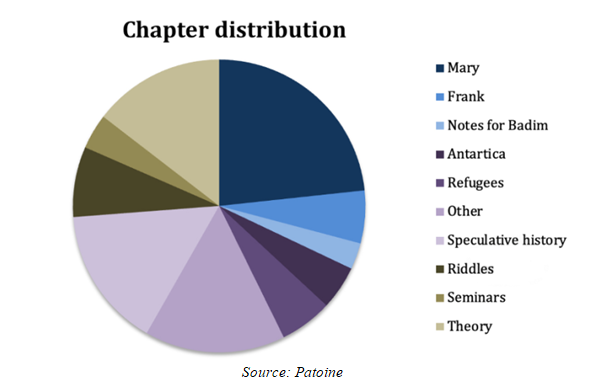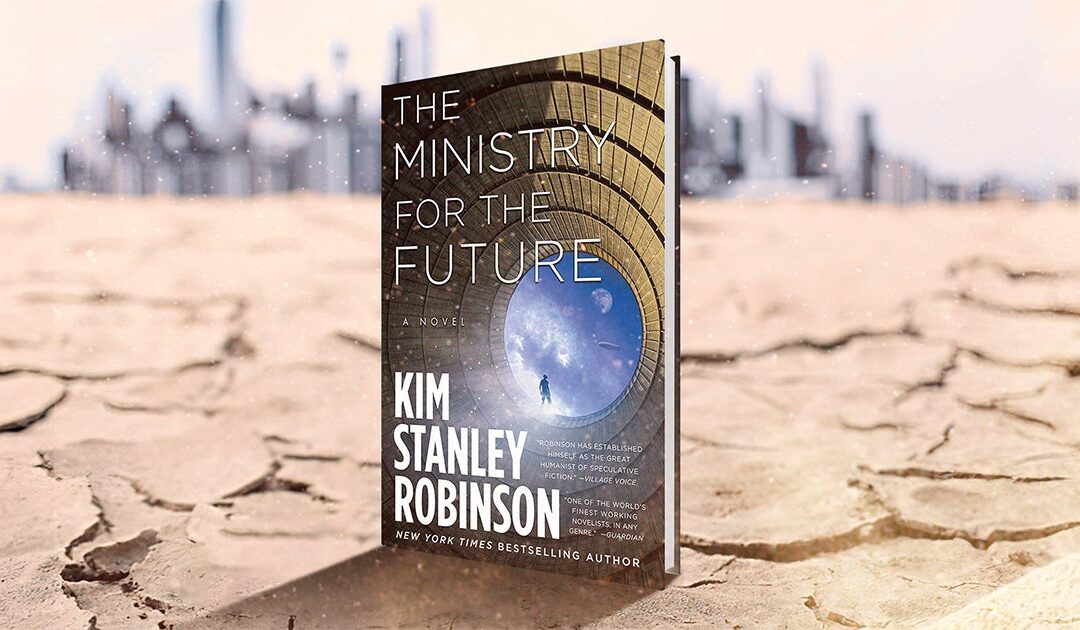Background
I put this essay together as part of my MFA with King’s College in Halifax. I’m checking out comparative titles, or books that are similar in nature to my project, which is Ecopia, a sequel to Extinction Event. I picked Ministry for the Future mainly because it delivers a solid punch with ideas about economic and systemic change, but also because the author, Kim Stanley Robinson, is a scholar with Philip K. Dick, an author I’ve admired for a long time.
In the TL;DR department, I have to admit I’m disappointed with the book. I think it’s an important effort, but KSR throws so much stuff at the wall in a hope to make something stick, it just gets covered with a veneer of data dumps and distractions.
Introduction
Kim Stanley Robinson’s (KSR) The Ministry for the Future (MftF, 2020) is a 563-page exploration of climate issues and possible solutions concerning life on Earth. The book’s genesis revolves around the signing of the Paris Accord in 2016, an agreement that implies that the world may experience a sixth extinction if humans don’t change our behaviour. From this very real launch point, KSR delivers a fictional arc that explores what might happen over the next thirty years if we ignore the warnings.
I picked this book as a comp title because it projects a utopian future that emerges after a lot of hard choices are made. Ministry calls for radical changes to economic and political systems in order to protect most species on the planet, including humans. Ecopia begins where KSR ends his story: a massive change has taken place, with The Remainders working through the wreckage.
Polyphonic Structure
To deliver these ideas, KSR uses a polyphonic[1] structure:
A patchwork of voices and points of view, weaving together political and techno-scientific actors, identified protagonists and anonymous characters, individual and collective voices, human, animal and geophysical actants.
KSR uses many plot diversions and different voices to allowthe book to “take on a huge load of material without sinking”[2]. There are entire expository chapters, journal entries, traditional dialogue, and interaction without dialogue (eg. Email or text messages). The primary POV is Mary Murphy, the director of the Ministry for the Future, but the narrative flow bounces between different secondary characters, omniscient voices used for riddles and vast sections of story that barely fit with the plot.
Here’s a visual representation of the book structure:

Robinson’s goal is to capture “eyewitness accounts from all over the world from crux moments over the next thirty years.”[3] Writing from the perspective of one character, setting or location would apparently minimizethe urgency of climate action. While most of the through line of plot revolves around Mary Murphy, KSR throws a large cast at the reader, expecting us either keep up with the idea that a village of people is on full display with his novel.
This is the first time I’ve encountered this approach. Unfortunately, my reaction was that the fragmented plot of MftF made the call to action feel limp, despite the intense heat wave depicted at the beginning. I tried to keep track of people and events (see attached chapter summary), but I still skimmed the expository moments and got annoyed when I couldn’t figure out a couple of the riddles.
Characters Drowning in a Sea of Data
As I read Ministry, I realized that I inadvertently used a similar approach with Extinction Event. It’s loaded with research-driven exposition. It’s impossible for me to not imagine people skipping entire chapters about Large Language Models or religious stories that fixate on apocalyptic scenarios.
To support his polyphony, KSR uses every possible form of POV, again to emphasize that the future of the planet shouldn’t rest on the shoulders of a single protagonist. However, as a reader, you’re rarely invited into a character’s head in a meaningful way, so emotional attachment withers at the expense of data dumps. His main characters – MaryMurphy, the head of the MftF, and Frank May, a survivor of a heat wave who spurs Mary to action – have great potential, but they never lift from the pages. From the chart above, less than a quarter of the story is centred on Mary and many of these passages are impersonal formats (eg. Texting or journal entries).
As I develop the dialogue for Ecopia, I’ve already started experimenting with using first-person POV for LP (my main character) and then have third-person discussions between other characters when LP isn’t present. My goal is to always give the reader someone to latch on to. That said, I have a strong desire to have multiple voices, and will use different techniques, including journal entries from characters like Eugene Case as he sets up bioacoustic recording labs for GAIA and witness testimonials or flashbacks as GAIA and their creator, Sylvie Hunter, come under fire for what they unilaterally decided for the human race.
Another interesting ‘character’ in Ministry is the group called ‘TheChildren of Kali’. They are an eco-terrorist group and important catalyst. Towards the latter half of the book, they force the world to capitulate with respect to carbon consumption. However, we never meet a leader and all of their actions usually materialize as comments in conversation with the other characters. Depending on your world view, they’re the closest KSR has to an antagonist in the plot. The absence of a clear villain (other than all of us) appeals to me, but there’s also a lack of energy and tension as a result. As an aside, I’m a big mythology geek, so I’m aware that Kali is the Hindu goddess of time, destruction and rebirth. The name is appropriate.
Despite using an innovative structure and delivering a cornucopia of ideas based on extensive research about how to save the planet, I’m worried that KSR may wind up doing more damage than good when it comes to trying to alert his readers to the urgency of the climate crisis.
A PhD thesis usually doesn’t yield a fun romp even when it’s about saving the planet (or maybe especially when?). Therefore, I’m working hard to integrate the research that I find interesting and convert itinto dialogue or journal entries that the reader will also find appealing. As mentioned above, Eugene Case will be given ‘permission’ to travel to the Amazon early in the book. As he travels, he’ll keep a journal of his notes and observations. In particular, I think it will be valuable to explore his relationship with his long-lost relatives, members of the Yanomami Indigenous people in the Amazon. He’ll struggle with his connection with these people and what it means to appreciate their culture as opposed to appropriating ideas about them. Case will also describe some of the process involved with translating animal communication and how he’s working with GAIA to create a collection of stories called Animalia. Both of these themes will expand as the book progresses. The stories from animals in particular will become vital to the trials that GAIA and Sylvie Hunter face back on Nova Doma.
Plot Needs Pace
Furthermore, in the Western world, plot needs pace, twists and turns to keep the reader’s attention. This will be my greatest challenge with Ecopia because I intend to share similar observations or ‘vignettes’ like KSR does, but I want to be alert to the need for connective threads and themes that the reader can follow. There will be tension and conflict, but the revelations and discoveries may be different from the typical explosive climaxes and denouement that we get with Western writing. This is the primary reason why I’m intrigued by the kishotenketsu structure.
Ultimately, there are many reasons why Ministry was a valuable comp read. I’m an ideas guy and I developed several concepts thanks to KSR. Towards the end, he uses evocative and loving images for the places that Mary visits once a global-scale reclamation project materializes. There were also subtle things like collecting DNA from stuffed animals and engaging in a de-extinction program or the use of drones and droids to reseed and reclaim habitats for animals.
Finally, Robinson has some great lines. My favourites being “the Invisible Hand never picks up the check,” (p. 411) and “our tools are expressions of our intentions” (p. 458). Both of these have stimulated a lot of discussion around our household and with friends and these distillations of massive concepts remind me that it will be worth revising this text again in the future.
[1] Pierre-Louis Patoine, “The Realism of Speculative Fiction: Planetary Polyphony and Scale in Kim Stanley Robinson’s The Ministry for the Future,” https://publications-prairial.fr/representations/index.php?id=437&lang=en#tocto1n2
[2] Arley Sorg, Eyewitness to History’s Future: A Conversation with Kim Stanley Robinson, https://clarkesworldmagazine.com/robinson_interview_2020/.
[3]J.P. Harpignies, “Interview with Kim Stanley Robinson about his book The Ministry for the Future, https://bioneers.org/kim-stanley-robinson-on-his-book-the-ministry-for-the-future/
